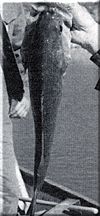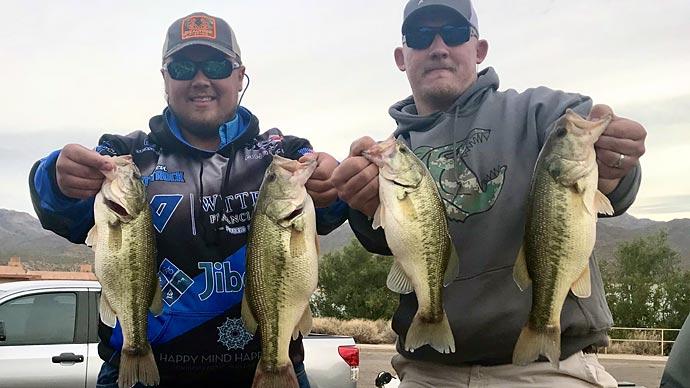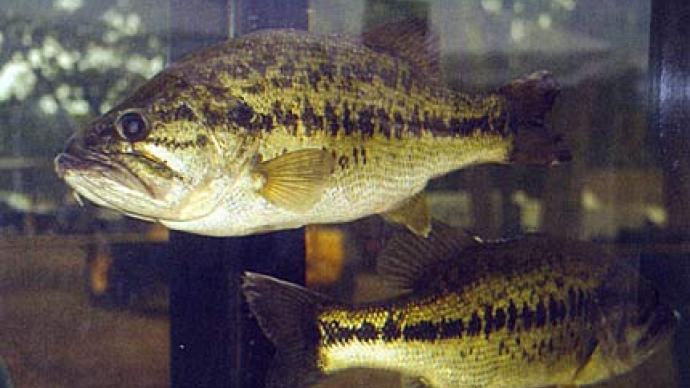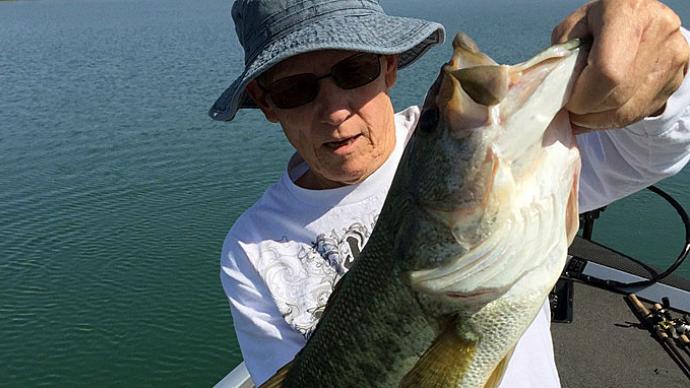The following is an excerpt from "Raising Trophy Bass," the new POND BOSS handbook by biologist Bob Lusk.

Twenty years is a long time -- unless it is spent managing big bass. Then, it swims by in a frothy blur. During my time in the fish management industry, virtually every possible scenario has passed over the transom of our travel adventures.
My crews and I have logged more than a million miles on eight different vehicles going to and from different lakes in Kansas, Oklahoma, Louisiana and Texas. That's a lot of windshield time to ponder our experiences. I never cease to be amazed at how human nature can get tangled up with Mother Nature to produce bad information. Then, that bad information gets passed along from source to source, which only makes the scientific fact more difficult to find and distribute.
From the ponds of California to the pools of the Carolinas, from the lakes of Maine to the reservoirs of Mississippi, myths and misconceptions abound -- especially about raising trophy bass.
In this chapter, we will dig into the fun, fact and frivolity of producing huge largemouth while developing into a full-fledged pond boss. Just how do you boss a pond?
One thing you do is understand that a myth is seldom a deliberate or devious attempt to misrepresent the truth or violate our common sense. Rather, they are attempts to entertain, to tickle. As such, these pitfalls of misinformation originate, not in the twisted mind of a serial murderer, but in the light heart of a good-natured story-teller.
Common sense? That gets lost in the telling. Here's a case in point:
A man called from southwestern Missouri to say he had recently bought a beautiful place, with a lake site, nestled in the northwest corner of Arkansas. His spring-fed six-acre liquid paradise was surrounded by scenic pine trees and huge old hardwood trees. Even the passive angler could not resist threading an earthworm on a hook and trying his luck. The new pond owner asked about Florida bass.
When someone calls, asking for small Florida bass, I don't hear a person wanting a plastic, oxygenated bag full of squirming two-inch fish with exceptionally large mouths. I figure the man pictures himself next to his son or daughter, in their metal john boat, on their very own lake. The kid's spinning rod is bent double, drag screeching. His cheeks are puffed out, his eyes wider than the oak trees around the lake. Next to the boat, a huge bass is tugging against the business end of the monofilament line. The kid's throbbing chest can hardly contain his pounding heart.
The man from Show-Me country wanted to buy 300 fingerling Florida bass to stock in his newly acquired lake. "Why? I asked. "Because," he said, "the bass I have are no good."
He tried to explain. Six months into his land stewardship, the new landowner came to the conclusion that his bass were stunted at eight inches. Based on reports from neighbors, the scenic lake had been that way for years. Thirty-five and 40-year-old locals remember catching eight-inch bass as youngsters, and now their kids were catching fish the same size.
The landowner had it figured out: Adding more bass would improve the gene pool. With new fish, he would have trophy fish jumping through the tire swing next to the dock.
I hated to burst his bubble, but I don't know that I've ever seen a "bad" bass or a fish that was "no good." Submit this case to the People's Court, and judge Wapner would throw it out for lack of evidence.
Fact is, the Arkansas pond, like so many with a catch record, simply had too many bass, not enough food. A body of water can produce a given amount of fish, no matter where it's located. Water supports only so many forage fish, so many predators. If one type overwhelms the other, individual growth in the gamefish/predators stops. This does not mean the fish are genetically inferior or "bad," nor does it mean the lake is no longer viable. It simply means the dynamics have slowed to a crawl. The Missouri pond owner was stuck on eight-inch bass simply because, once his fish reached a certain weight, their growth was halted by limited food and space.
The pond owner corrected that problem by taking out high numbers of small bass and stocking adult bluegill to provide a forage base. He also set up a supplementary feeding program to add high-protein pellets, and he began adding fertilizer to the water to make it more fertile.
A year later, he was able to stock a few intermediate-size Florida bass to change the genetics. Had he purchased the Florida fingerlings, they would have ended up as snacks for the larger bass.
One client from Fort Worth, Texas called with a dilemma. He had done everything right -- or so he thought.
His 50-acre lake, southwest of the Fort Worth area, was built with giant bass in mind, long before sculpting a take bottom with bulldozers was cool. This guy's lake had all the right cover, including creek channels, standing timber, flooded humps, brush piles, the works.
The lake was completed in 1985, and soon filled with water. In the autumn of that year, the pond owner stocked the reservoir with fathead minnows and coppernose bluegill.
The next spring, 1986, the amateur fish manager ordered pure-strain Florida bass from a hatchery in Florida. Arrangements were made to fly the fish in tropical fish boxes from Tampa's airport to DFW Regional. All told, the Texas pond owner imported 2,500 fish, most only slightly larger than an inch.
Carefully, he stocked the little creatures in their new home. With fathead minnows everywhere, the bass grew extremely fast.
By 1988 he and friends were catching bass that weighed four pounds, with a few football-shape females pushing six. He started a slot limit in 1989, that is removing any bass he caught that measured less than 14 inches in length.
Gizzard shad, established two years into the project, schooled all summer and not only fed the fish, but gave visiting anglers a good place to start their fishing outing. Big bass began to rule the lake. The lake owner was looking like the wizard of black bass, then came 1995.
This magnificent trophy bass lake made a dramatic change and blind-sided the owner. He thought, once his trophy bass lake matured, it would stay that way forever. A wide-spread myth.
Truth is, getting a lake to trophy status is a major task and, once that goal has been accomplished, there's no room to become complacent.
In this case, 11 years after the lake was originally stocked, the large bass began to lose weight, and rapidly. In one season 10-pound bass shrank to six-pounders. By 1996, the same hungry looking fish weighed five. Once huge, the skinny largemouth looked like victims of some Third World famine.
This was the unhappy results of two different problems. We quickly ruled out disease and parasites. A fish pathologist examined a sample of ten fish and found nothing out of the ordinary.
First, these aging fish were 11 years old, moving past the prime of their lives. The graybeard bass had lived, thrived, dominated this waterway for years, but the sun was setting on their mottled green backs.
Secondly, their food chain had diminished. How? Blame it on the slot limit.
By leaving the slot limit in place so long, two things happened. One, there were too few rising healthy, young stars to take the place of veteran trophies. Secondly, big bass eat big bass. A 15- pound bass will inhale a two-pounder, and keep it down.
Meanwhile, the gizzard shad population was not maintained. Over a two-year period, shad disappeared from the lake, victims of the big bass.
Turns out, the slot bass became the food chain for big bass. As trophy bass dominated the population, as many as 80 percent of these ambush experts were 18 inches or larger. That percentage is too high for long-term management.
Something had to give. In this case it was the heroes, not the goats.
How to fix this problem? Nurture young bass, grow them into the system. It cost the lake owner three years, but it worked, by stopping the slot limit. If he had known the effects, this bassologist could have stopped the slot much earlier, and had young bass groomed for trophyhood. This was a classic example of how slot limits must change when the fishery is ready. If you listen, the fish tell you when.
A call came from a man in southern Louisiana. He had a rice field reservoir, and was trying to manage it for trophy largemouth bass. Three years into his plan, fish seemed to be scarce. After asking a few questions, it was easy to see he was not executing a management plan, he was executing his fish.
Generally, a rice reservoir is a large lake built with a track hoe, dragline, or a dozer. The heavy equipment makes a levee around the perimeter of a large, flat field. The levee is raised six or eight feet above ground level, giving a 10-to-12 foot deep channel around the edge.
The lake is pumped full, usually with big diesel-powered water pumps, sucking massive amounts of H20 from a nearby bayou. Rice farmers capture runoff when they can, then use the stored water to flood the crop during the hot summer months. The middle of these takes tend to be shallow, with the deepest water around the edges.
This fervent, new outdoorsman, a novice in fish management, had moved from the Chicago area, to escape big-city life and the hassles that go with it. He leased the lake, read all the literature he could find from university sources, county agents and government files. The information was piecemeal, so he didn't quite get the whole picture.
The middle of the lake, which covered about 12 acres, had a sparse amount of standing timber, probably an acre. This cover stood in water less than five feet deep.
In June one year, he stocked bluegills, shellcrackers, fathead minnows and bass at the same time. Somewhere in his reading he remembered a passage about establishing a slot limit.
This he set the following September, urging anglers to keep every bass they caught less than 12 inches. See the problem? Throw in the fact the standing timber became a perch for the lawless double-crested cormorant, and he had the recipe for over-harvest. He was doomed to a quick failure.
When asked how many bass he and his fishing buddies had removed, the pond manager nonchalantly said, "Oh, 400-to-500." All this before Christmas, less than seven months after stocking. He only stocked 750 bass in the first place. Throw into the mix 200 hungry water turkeys, and the stocker bass never stood a chance. When asked how the sunfish were doing, the pond manager said, "Fantastic, there are millions of them." That's what you would expect.
A crash course in Fisheries Management 101 does not cover the concept of slot limits and their implications. Remember the actor David Carridine in those Kung Fu TV series? As a boy, his mentor said, "Grasshoppa, be patient, you will know when the time is right?" Bass will tell you when the time is right.
To order a copy of "Raising Trophy Bass," send $19.95, plus $3.05 shipping (Texas residents add $1.90 for sales tax, total $24.40) to: Pond Boss, POB 12, Sadler, TX 76264.
Reprinted with permission from Pond Boss Magazine



